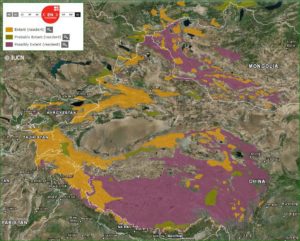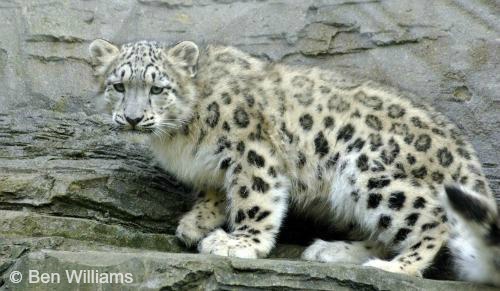- HB Length: 86-125 cm (34-49″)
- Tail Length: 80-105 cm (31-41″)
- Height: 60 cm (24″)
- Weight: 22-52 kg (48-115 lbs)
- Pop. Trend: Decreasing
Unique among wild cats, the beautiful smoky grey fur of the Snow Leopard Panthera uncia has been the cause of their near extinction at the hands of man. First brought to the attention of Europeans in 1761, their thick, plush fur became popular worldwide. In spite of legal restrictions, their wild population plummeted.
Their long, dense fur is smoky grey to yellowish, and a pattern of large, dark rosettes and spots allows them to blend completely into their snow covered rockyy terrain. Unlike most spotted cats, the Snow Leopard has paler, less distinct spotting on the body and flanks. The head is dotted with smaller, round black spots. The chin, chest and belly are almost pure white. Being an animal of high altitude, their woolly fur is exceedingly long, up to 2.5 cm on the back and six cm on the belly. Their long, rounded tail is used as a wrap for warmth when sleeping, and the fur on the tail can be up to five cm long. Several rosettes form black rings on the upper side of the tail, with less distinct spotting on the underside.
The Snow Leopard is intermediate between big and small cats. Like the small cats, Snow Leopards purr but cannot roar, and they feed in a crouched position. Their skull is large, shortened and broadened with a short muzzle, high forehead and vertical chin. Irises are pale yellowish to greenish grey, and the pupils are round. The backs of their short, rounded ears are black at the tips and the base, with grey bars. Short, rounded ears are an adaptation for stalking prey in areas of little cover, an adaptation shared by other mountain and desert dwelling species. Their broad foot pads are covered with a cushion of hair which increases the surface area and distributes their weight more evenly over snow. This cushion also protects their pads from the intense cold.
Distribution

These beautiful leopards are found in 12 countries in Central Asia, and their habitat includes some of the world’s highest mountain ranges. Historically found over much of high altitude Asia, including Mongolia, China through Russia, Afghanistan, Pakistan, India and Nepal, they have probably never been common, due to the harsh environment.
They inhabit steep rugged terrain, alpine meadows, rocky areas, snow fields and glaciers up to 5,500 metres. In winter, they follow the game to lower levels, down to 500-1,500 m in the Gobi Desert.
Radio telemetry studies have found that due to the scarcity of prey, Snow Leopards possess vast territories, which they defend by scent marking, scrapes, and fecal deposits. One radio-collared female in Mongolia was estimated to hold a territory of at least 1,590 square kilometres while male ranges were 181 – 1,628 square kilometres. Daily movements may be as much as 28 km or more.
Researchers from The Snow Leopard Trust have found that up to 40% of all protected areas across the Snow Leopard’s range are too small to support even a single breeding pair, let alone a viable population. In contrast to previous studies, they also found very little overlap in home ranges of adult cats of the same sex, suggesting that Snow Leopards are highly territorial.
It is very difficult to assess population numbers of these rare leopards, and estimates from camera trapping studies vary from 0.15 cats per 100 square kilometre in Kyrgyzstan to 4.5 cats per 100 square kilometres in a prey rich habitat.
Ecology
The agile Snow Leopards are renowned for their leaping ability, executing jumps from six to 15 metres through the air. Their long tail, up to two metres, acts as an effective counterbalance. Exceedingly shy and secretive animals, they prefer to move along ridge lines, edges of bluffs and bases of cliffs which provide an excellent view of the surrounding area. These solitary animals are active early morning and late evening, and often rest on huge nests built by black vultures during the daylight hours. These vantage points are not reached by climbing, but by jumping.
In the winter months, Snow Leopards consume a large portion of plant matter, much of it willow bark. Like the Cougar Puma concolor of North America, Snow Leopards stalk their prey from an uphill position, creeping up and then grabbing it in a sudden spring. There is no record of any unprovoked attack on man.
Reproduction
Mating occurs in late winter or early spring, with one to five, usually two or three, cubs born after a 90 – 104 day gestation, weighing 450 – 500 grams. Births occur from April to June beneath rocks or in rock crevices, in dens lined with fur. Cubs initially have completely black spots, lacking the lighter central area of the adults. Their eyes open in seven to nine days, they begin crawling after 10 days, and at two months begin eating solids. The family stays together until the following winter. Sexual maturity is reached around two and a half years in captivity, although it is believed to be later in the wild. In captivity, they have lived to 21 years of age.
Conservation
Snow Leopards have suffered tremendously at the hands of man. There are an estimated 2,000 – 4,000 of these magnificent cats left, currently spread over a wide arc of the Central Asian highlands.
Poaching and illegal trade has been a traditional threat and continues in many parts of their range. Currently, the demand for rugs, luxury décor, and taxidermy, especially from China and Eastern Europe appears on the increase.
There is considerable variation in the type and extent of threat among countries, especially with respect to large countries such as China or Mongolia where suitable habitat is extensive and split across different administrative regions. The main ongoing threats fall into three broad areas: 1) competition with livestock, habitat degradation and declines in prey; 2) depredation by Snow Leopards on livestock and retaliatory killing; 3) illegal trade in furs, bones and other body parts.
New threats have been identified since 2003, including climate change, mining, large scale infrastructure and barriers such as roads or fenced railway lines. A further set of localized threats include the lack of awareness among local people and policymakers, insufficient law enforcement, and limited trans-boundary collaboration.
Over 90% of annual Snow Leopard poaching is estimated to occur in five range countries: China (103-236 animals poached per year), Mongolia (34-53), Pakistan (23-53), India (21-45) and Tajikistan (20-25). While the highest levels of poaching and illegal trade are in China, which has the largest share of Snow Leopard range, countries with smaller shares of global range were flagged for having disproportionately high levels of estimated poaching (Nepal and Pakistan) and illegal Snow Leopard trade (Afghanistan and Russia). Afghanistan, Bhutan and Kazakhstan had markedly low levels of seizures compared to observations of poaching and illegal trade, suggesting the need for strengthened law enforcement in these countries
Even though they live in remote, inhospitable areas, Snow Leopards are rapidly declining at the hands of man.
Read about the small Pallas’ Cat that lives throughout much of the Snow Leopard range.
Range Map IUCN Red Data List (2008)
Updated 2017


DeerLover
What an interesting creature. Doing a paper on them, and I am enjoying it.